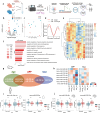Knockout of the longevity gene Klotho perturbs aging and Alzheimer's disease-linked brain microRNAs and tRNA fragments
- PMID: 38862813
- PMCID: PMC11166644
- DOI: 10.1038/s42003-024-06407-y
Knockout of the longevity gene Klotho perturbs aging and Alzheimer's disease-linked brain microRNAs and tRNA fragments
Abstract
Overexpression of the longevity gene Klotho prolongs lifespan, while its knockout shortens lifespan and impairs cognition via perturbation of myelination and synapse formation. However, comprehensive analysis of Klotho knockout effects on mammalian brain transcriptomics is lacking. Here, we report that Klotho knockout alters the levels of aging- and cognition related mRNAs, long non-coding RNAs, microRNAs and tRNA fragments. These include altered neuronal and glial regulators in murine models of aging and Alzheimer's disease and in human Alzheimer's disease post-mortem brains. We further demonstrate interaction of the knockout-elevated tRNA fragments with the spliceosome, possibly affecting RNA processing. Last, we present cell type-specific short RNA-seq datasets from FACS-sorted neurons and microglia of live human brain tissue demonstrating in-depth cell-type association of Klotho knockout-perturbed microRNAs. Together, our findings reveal multiple RNA transcripts in both neurons and glia from murine and human brain that are perturbed in Klotho deficiency and are aging- and neurodegeneration-related.
© 2024. The Author(s).
Conflict of interest statement
The authors declare no competing interests.
Figures





Update of
-
Knockout of the longevity gene Klotho perturbs aging- and Alzheimer's disease-linked brain microRNAs and tRNA fragments.bioRxiv [Preprint]. 2023 Sep 12:2023.09.10.557032. doi: 10.1101/2023.09.10.557032. bioRxiv. 2023. Update in: Commun Biol. 2024 Jun 11;7(1):720. doi: 10.1038/s42003-024-06407-y. PMID: 37745362 Free PMC article. Updated. Preprint.
References
MeSH terms
Substances
Grants and funding
LinkOut - more resources
Full Text Sources
Medical
Molecular Biology Databases

